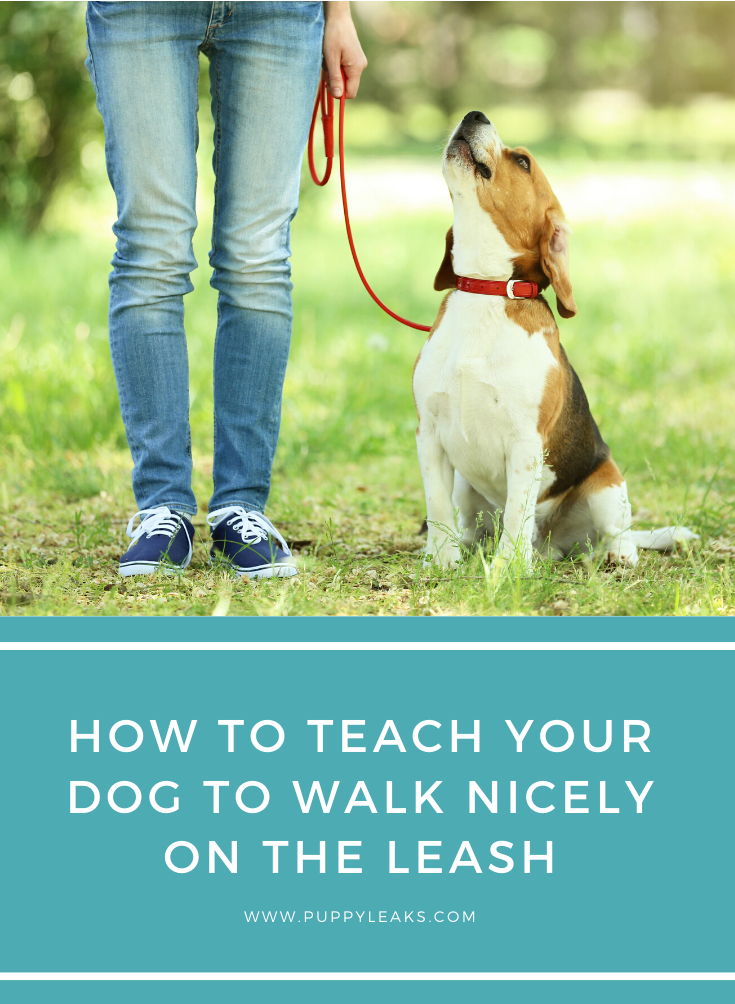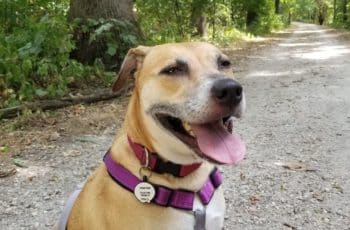If there’s one thing I envy at the park it’s seeing dogs that walk perfectly by their owner’s side. Another dog coming up? Doesn’t phase them at all. A trio of excited kids approaching? The dog doesn’t seem to notice.
My dog and I used to be the complete opposite. I was the lady trying desperately to keep my dog calm on walks. I’d be holding her back with all my power whenever someone walked by, and I was the one with a tight grip even when nothing “exciting” was around because pulling became her default on walks.
But a few years back I finally found some tips that helped. After reading and watching everything I could find on the subject I found some methods that worked. In this article we’ll go over why dog’s pull, methods to stop the pulling, and why consistency is key. Here’s how I stopped my dog from pulling on the leash.
Why Dog’s Pull on Leash
Before diving into the methods that can stop your dog from pulling on the leash let’s take a quick look at why dogs pull to begin with. As with many other behaviors understanding why dogs pull on the leash on the leash to begin with, and how many of us inadvertently encourage it, can make managing the behavior easier.
Dogs pull on the leash because it’s normal canine behavior. Is it desirable? No, but it is natural to them. Pulling gets them where they want to go, and it gets them their at their own pace. They don’t pull because they’re trying to be dominant, they do it because it works. In other words, if you’re behind your dog on walks and they’re pulling you’re teaching them to pull even more. That pulling is being rewarded because it keeps them moving forward and getting to where they want to go.
If your dog has always pulled on leash it’s going to be a hard habit to break. Because they’re used to moving forward while pulling the behavior itself has been encouraged, and a dog’s natural reflex is to oppose restraint. But if you’re consistent you can break that habit, and over time you can put and end to all that pulling by showing your dog that walking by your side is much more rewarding.
Not All Methods Will Work Perfectly For Every Dog
If there’s one thing you need to before you begin any kind of training it’s that not every method will work for every dog. I’ve tried many methods when it comes to loose leash walking, and I always felt like a failure when one didn’t work. So if you’ve read up on loose leash pulling in the past but didn’t see results you’re not alone.
Much of dog training is about finding what motivates you dog, and building on that. For Laika I stuck with methods that offered good incentives for my dog — ones that included lots of yummy treats and toys as motivation.
Have you ever heard of the be a tree tip? It goes like this — when your dog begins to pull on a walk you stop and stand still. The theory is that your dog will learn that pulling means you’re gonna pause the walk, therefore he won’t pull anymore.
Do you know what happened when I tried that with my excitable dog that was already used to pulling on leash? She pulled even harder to get where she wanted to go and got frustrated when I wouldn’t move. If you’re patient enough you might be able to have success with this method, but it didn’t work very well for my dog. I tried for months, and I was stuck on the side of the road who kept stopping every 3 feet to stand still for a couple of minutes hoping my dog would choose to settle down. But that didn’t happen. At best she’d stay at the end of the leash looking forward, and sometimes she’d stop for a moment but as soon as we started moving again she was right back to pulling.
Being a tree didn’t work for my Laika — part of that’s due to her excitability, and part of it’s due to the fact that she was already used to pulling to get where she wanted to go. When it comes to keeping your dog from pulling on the leash you’re going to have to find a method that motivates your dog.
Now this isn’t to say that be a tree doesn’t work well for some dogs; I’ve seen it work. It just didn’t work well for my dog, and might not be the best method if you have a dog that’s been pulling for a long time.

When it comes to training your dog to walk nicely on the leash keep one thing in mind — not all methods work perfectly for every dog. Don’t get discouraged if one single method doesn’t work with your dog. Part of dog training is figuring out what motivates your dog, and building on that.
1. Pick One Walking Method and Stick With It
The first tip when it comes to teaching your dog not to pull on the leash is picking one walking method and being consistent. You need to teach your dog what behavior is acceptable on a walk, so figuring out how you want your dog to walk and being consistent with that goal is the quickest way to get there.
Do you want your dog to walk on your right side, left side, or a few steps behind? Pick your preference and stay consistent. If you want your dog to stick to your right side at all times make sure everyone who walks him sticks to that plan. Sticking with one method will help teach your dog exactly what’s expected of them on a walk, and will make training go smoother.
2. Start in a Non Exciting Area
When it comes to teaching your dog how to walk nicely on a leash one thing you want to avoid is setting them up to fail. So when you’re trying to teach your dog to remain calm and walk nicely it’s important to use a non exciting are for you training. Pick a quiet time of the day and practice walking down the street, go for an evening stroll during dinner time when most people are indoors, or go to a park during non peak hours.
If you take your dog to a crowded park before they have good leash manners (and proper impulse control) chances are they’re going to be far too excited and stimulated to pay attention and learn anything. They’ll be far too distracted by all those exciting sounds, smells and sights — and of course squirrels. Don’t set your dog up to fail like that. Start by teaching your dog how to walk nicely in a calm area and build from there.
3. The Cheater Method: Using a Front Clip Harness
My favorite method when it comes to teaching your dog not to pull on the leash is one I call the cheater method — using a front clip harness. The best part is front clip harnesses are easy to use; the hardest part is figuring out how the hell to put them on the first couple of times.
I have zero regrets about getting a front clip harness years ago, in fact it’s one of the tools I wish I’d had from the very beginning. I’ve never seen a single piece of equipment have such an immediate impact on walks. Using a front clip harness is one of my favorite dog walking tips for that very reason; it’s a nice simple way to help “reset” your dog’s leash manners if you haven’t been using one.
Using a different piece of gear works especially well on dogs that are already accustomed to pulling with a traditional collar/leash combo. From the moment you start using your new harness keep up the praise as your dog walks nicely. Your dog will start to associate the harness with loose leash walking.
It’s the same method used by a lot of police K9s. They have different collars they wear depending on the tasks they’re being given. A simple switch of their collar puts them into a different mindset, and they know exactly what is expected of them.
Before using that harness I had been using a traditional leash and collar, and Laika had already grown accustomed to pulling. She would start pulling immediately as soon as we got out the door, but once I switched to the front clip harness that changed. She wasn’t used to that harness, or having a leash that clipped in the front — so I took advantage of that period and started teaching her nice walking manners while she adjusted to the new piece of gear. It didn’t take long for her to catch on, and since then our walks have been much more enjoyable.
4. Use Treats to Encourage Your Dog to Follow You
Whatever method you end up using to keep your dog from pulling on the leash the most important thing to remember is that you have to keep your dog motivated. To help encourage them to walk nicely you need to show them that good things happen when they do, and the easiest way to accomplish that is by using yummy treats. Giving your dog something positive for a certain behavior will encourage them to repeat that behavior, and loose leash walking is no exception.
So when you start teaching your dog how to walk on a leash remember to use treats (or toys if your dog is more play motivated) to encourage them to follow you. This will show them that walking nicely without pulling on the leash means good things happen, and in time they’ll start to repeat that behavior on their own.
Resources & Recommended Reading



